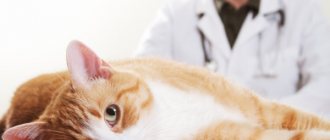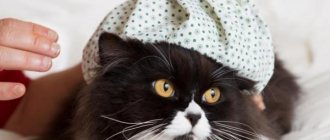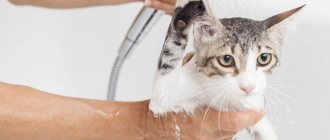Veterinarians call leptospirosis in cats one of the most terrible diseases for a pet. The virus can be transmitted from the carrier to healthy relatives or humans. A severe form of the pathology causes a high mortality rate in humans and animals. Every owner of a furry pet should know the characteristic signs of the disease.
Causes of leptospirosis
The causative agent of the infection is bacteria of the genus Leptospira. They enter the animal’s body through damaged soft tissues or mucous membranes. Leptospira survive for a long time in stagnant water, as well as in other warm and humid environments.
Most often, cats become infected with leptospirosis if they come into contact with dirty standing water or other animals that carry the bacteria (for example, rodents). Most infestations occur in spring and autumn.
Leptospira is transmitted through the placenta, secretions from the lungs or genitals, or insect bites (for example, ticks). Infection often occurs after animals come into contact with the urine or feces of infected pets.
After infection, the animal remains a carrier of the pathogen for up to 3 months.
Prevention
In order to reduce the risk of infection with leptospirosis, it is necessary to treat the animal's bed, toys, bowls and other items for use with disinfectants. Leptospires quickly die upon contact with disinfectants and boiling water. The pathogen exhibits resistance to low temperatures.
As a preventive measure, regularly control rodents, since in most cases they become the source of infection for cats. Make sure that your pet does not come into contact with stray cats, stagnant water, or eat low-quality or street foods. Animals that do not walk outside rarely develop leptospirosis.
The pet's immune status plays an important role. To increase the body's defenses, you need to provide your cat with a complete diet containing all the vitamins, minerals and nutrients necessary for its normal development. The owner of the cat must monitor the state of its health, immediately taking measures to eliminate diseases that lead to weakened immunity. At least once a year, give your pet vitamin complexes designed to improve the immunity of cats.
If in the yard where the cat lives there are farm animals - cows, horses, etc., you need to take care of their vaccination. There is no vaccine to prevent the disease in cats.
If the immune system of a healthy cat is able to resist Leptospira, then when these bacteria enter the human body they cause serious problems. Therefore, when taking measures to prevent your cat from becoming infected, remember about the health of the people living near it. The main rules of prevention for humans are compliance with sanitary and hygienic standards and vaccination.
Source: koshek.ru
Symptoms of a bacterial infection
Pathogenic microorganisms (leptospira) enter the circulatory system through damaged soft tissue. Gradually they spread throughout the body, affecting the main systems: nervous, visual and reproductive, as well as the cat’s brain.
The severity of the infectious disease depends on the general condition of the body. If the animal’s immunity is weakened, then the likelihood of developing severe leptospirosis and complications increases significantly. At the same time, the risk group includes small kittens up to 5-6 months and pregnant cats.
On average, the incubation period lasts from 3 to 10 days. The main signs of leptospirosis:
- increase in body temperature (normal body temperature in adult cats ranges from +38 to +39.5 °C),
- a shaky and uncertain gait, as well as muscle stiffness in the pet’s hind legs, which makes it difficult for him to make any movements,
- complete lack of appetite in the animal and loss of body weight,
- dyspeptic disorders (most often there is profuse diarrhea with blood clots, vomiting is possible),
- icteric tint of the mucous membranes and conjunctiva of the eye,
- apathetic and lethargic state,
- dyspnea,
- enlarged lymph nodes.
The first thing many owners pay attention to is the deterioration of the pet’s general condition. The cat moves less and refuses to eat. Many animals have difficulty swallowing (dysphagia). Without timely treatment, the pet begins to experience repeated bouts of vomiting, with the vomit consisting of bile and gastric juice.
Penetrating into the body, Leptospira affects many internal organs, so the clinical picture of the disease is extensive. If even 1-2 signs of infection are detected, you should immediately contact a veterinarian in Moscow and undergo an examination. This is the only way you can find out if your cat has leptospirosis and begin treatment for the disease.
general characteristics
Under a microscope, Leptospires appear as slender parasites with a corkscrew shape. Science knows that there are a huge number of types and serological groups of such a parasite in nature. Fortunately, they are not resistant to disinfectants, do not tolerate sudden changes in temperature and practically do not survive in the external environment.
It is important to understand that the bacterium is transmitted not only from sick cats, but also from animals that have already recovered from the disease. Your furry friend can become infected through the urine, feces or milk of Leptospira carriers
Even after full therapy, the cat remains a carrier of the microorganism for another 3-4 months.
Veterinarians are convinced that feline leptospirosis is most often spread through food, water and direct contact with an infected animal. Leptospirosis carriage has also been observed in rodents and insects such as ticks and mosquitoes. Bacteria enter the body primarily through the mucous membrane of the digestive tract, respiratory tract and genitourinary system.
Stages of the disease: how does leptospirosis develop in cats?
At the first stage, pathogenic microorganisms (leptospira) rapidly multiply in the blood and parenchymal organs: liver, spleen, kidneys, as well as the thyroid and pancreas. At the same time, the permeability of blood vessels sharply increases. Detection of antibodies is possible 5-7 days after a cat is infected with leptospirosis. Signs characteristic of the first stage include an apathetic state, refusal to eat, and increased body temperature.
At the second stage, pathogenic microorganisms (leptospira) disintegrate and their toxins are released, which impair the functions of the liver and kidneys.
This leads to the development of hepatorenal syndrome - acute renal failure (ARF) and severe liver damage. A characteristic condition for the second stage of leptospirosis is capillary toxicosis. It causes the capillary walls to become very brittle and brittle. Numerous hemorrhages occur, and against their background - necrosis of internal organs.
A cat was found to have a spirochete
Hello. Thank you very much for your answer. Since the appearance of blood and mucus in the stool (since May 2013), stool stabilization therapy was carried out four times: the first polyoxidonium and enterofuril; the second trichopolum; the third hophytol, sulfasalazine. The use of the drugs gave some relief for some time the blood and mucus disappeared. But the cat continued to lose weight (weight loss was already 800 grams). The fourth prescription was made by Aksenova E.P. (she was in Moscow on a business trip): roncoleukin, sinulox, trichopolum, dicynon, canephron. After the cat started taking the drugs came back to life in two days. Within a week, the weight gain was 400 grams. The blood and mucus disappeared. But after I started taking Canephron (I didn’t start right away, about 8 days after starting the main therapy), blood and mucus appeared again. The cat I did not deworm. Twice tested for helminths and protozoa in a preservative - negative, did scatology twice (stool was delivered after 20 minutes) - negative. The cat was diagnosed with coronavirus (stool PCR in May 2013). The spirochete was found on August 13, 2013 in a large quantity. Today the cat feels good, his appetite has not disappeared for a single day, activity is normal. He has gained another 200 grams in weight. But when he goes to the toilet it becomes scary. Mucus and blood are always at the end of bowel movements, the blood is dark in color (before sometimes it was red). It feeds on ecanuba entestinal. What other tests would you recommend (if necessary)? And what should we do next?
Diagnosis of the disease
Only a veterinarian can make a diagnosis after a preliminary examination. Leptospirosis has specific symptoms, but diagnosis in any case requires laboratory tests. They are necessary to determine the form and severity of the infectious disease, as well as to prepare a treatment plan.
Methods used to diagnose leptospirosis in cats:
- blood and urine tests (biochemical, general),
- microagglutination (MAT) to detect antibodies to the pathogen,
- polymerase chain reaction (PCR),
- enzyme immunoassay (ELISA), etc.
The treatment program for leptospirosis in a cat is drawn up taking into account the stage and form of the disease, as well as its general condition.
How is leptospirosis treated?
First, and most importantly, do not self-medicate! This is a dangerous infectious disease, which without contacting a reliable veterinary clinic in Moscow can lead to serious and often irreversible consequences for the health of the animal.
If the disease was detected at the first stage, then treatment is aimed at combating pathogenic microorganisms (leptospira) and preventing their further reproduction in the cat’s body. In cases where the infection is detected at a later stage, the main goal of therapy is to remove toxins and maintain the functions of damaged internal organs (liver, kidneys, spleen, etc.).
Treatment methods for leptospirosis:
- Immunotherapy . It involves the use of leptospirosis serum, which strengthens the immune system. It gives excellent results, but only at the first stage of the disease, while there is no serious damage to internal organs.
- Antibiotics . Leptospira are cellular pathological microorganisms, so antibiotics are used to eliminate them. The greatest effectiveness is achieved by combining several drugs at once, but when prescribing them it is important to take into account all contraindications.
- Infusion therapy . Most often, infusion saline solutions with a high concentration of potassium ions are used. Additionally, hemodez with glucose is used to eliminate signs of dehydration and restore the cat’s general well-being.
- Osmotic diuretics . They are used in the second stage of the disease, when renal failure develops. If the process intensifies, the veterinarian may prescribe anabolic hormones.
- B vitamins . Along with them, folic acid (vitamin B9) and ascorbic acid (vitamin C) are prescribed. They restore liver function and prevent the development of liver failure.
- Symptomatic therapy . It is aimed at eliminating the main signs of leptospirosis, which include vomiting, dehydration, numerous hemorrhages, etc. Additionally, medications are prescribed that strengthen the pet’s body.
On average, the course of treatment lasts from 1 to 2 months. During this period, all veterinarian recommendations must be followed. Strictly follow the regimen of taking medications, especially antibiotics. If the cat's condition worsens, immediately contact the veterinary clinic for a secondary examination!
Is leptospirosis transmitted from cats to humans?
Yes, leptospirosis is contagious to humans. About 16 leptospira are now known, which are dangerous for both humans and domestic animals. Leptospirosis manifests itself differently in people, but the main symptoms of infection include muscle pain, general weakness and dyspeptic disorders (profuse diarrhea). All this requires immediate consultation with a doctor to avoid the development of inflammatory processes, acute renal failure (ARF) and other consequences.
Leptospirosis is a dangerous bacterial infection. The sooner you seek help from a veterinarian in Moscow, the higher the likelihood that the cat will return to a healthy life and avoid serious consequences for the body.










